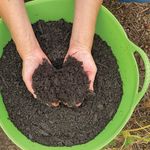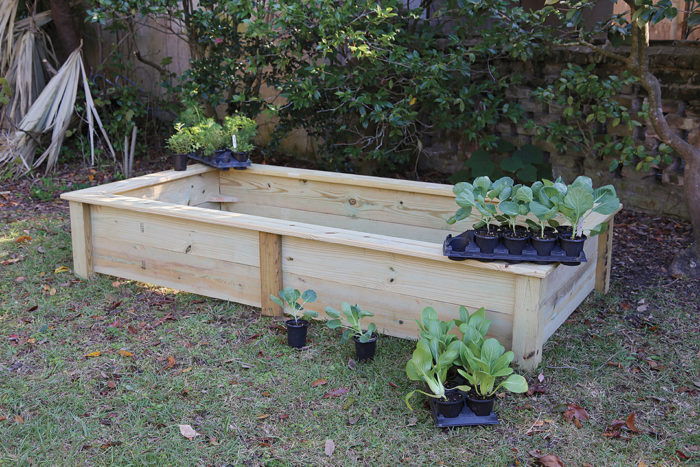A Stylish Raised Bed Almost Anyone Can Build
The materials for this bed are basic, the plan is straightforward, and the result is good looking

By now, we all know the perks of raised beds. They are an aesthetically pleasing way to grow edibles and cut flowers. Because they are essentially large containers, you can fill them with a high-quality soil mix to ensure that your garden has the best chance for success. And the soil heats up faster in a raised bed, giving you a jump on the season. For all of these reasons, my company has been asked to build raised beds more and more in recent years. Over the years, we’ve perfected what we consider to be the easiest, most affordable, best-looking raised-bed plan possible.
There are many designs for raised beds out there, but this one uses common materials found at any lumber or hardware store. You or anyone else who has basic carpentry skills and the right tools can build it in a day. We’ve found the ideal size for a raised bed is 4 feet wide by 8 feet long by 16 inches tall. This enables easy access to the interior of the bed, and the cap boards that frame the top of our beds enable you to garden while seated around the edges. We use pressure-treated lumber because of its durability and low cost. In order to prolong the life of the lumber and prevent the chance of anything leaching from the wood into the bed’s soil, we use a non-VOC waterproofing paint on the inside of our beds. Since pressure-treated lumber shrinks as it dries, it’s best if it has had some time to dry out beforehand. Be sure to buy lumber that’s free of knots and isn’t bowed or cupped. Finally, use stainless-steel screws to help prolong the longevity of the raised bed.
MATERIALS
Lumber
8-ft.-long 4×4 (1)
8-ft.-long 2×4 (1)
12-ft.-long 5/4×6
deck boards (2)
12-ft.-long 2x8s (4)
Hardware
3-in. 9d stainless-steel wood screws (75)
2-in. 7d stainless-steel trim screws (25)
Paint
Flexible, water-based, solvent-free, non-VOC waterproofing paint
(1 gal.)
TOOLS
• Miter saw and/or circular saw
• Tape measure and carpentry pencil
• Rafter square
• Drill with 1/8-in. bit
• Cordless drill-driver
• 4-ft. level
• Paint roller and tray
Plan
The bed blueprints
Use this drawing to help visualize the building process and to home in on the details of attachment.

STEP 1 | Cut the wood to size
Using a miter saw or circular saw, cut the wood into the lengths that you need for building the raised bed. Mark the square cuts with a rafter square to make sure they are exactly 90° (1). Again using the rafter square, mark the 45° cuts for the cap boards (2). If you don’t have a large enough miter saw to finish every cut (3), you can start some cuts with the miter saw and then finish them with a handsaw or a reciprocating saw.
STEP 2 | Build the long sides
Attach the longest boards (7 ft. 3 in.) to the corner posts to build the two long sides of the bed. It will be helpful to have a second person and/or a workbench when doing this step (1). Connect each long board to the corner posts using the 3-inch screws, driven at an angle from the inside (2). Drill pilot holes first using a 1/8-in. bit. Set the long boards flush with the inside of the corner post. After installing the first board, install the second in the same way. If needed, use a clamp to hold the boards together tightly. If the corner posts are a little longer on one side, just designate that side as the bottom.

STEP 3 | Install center braces for stability
Find the center of each side piece that you have just created. Clamp a 15-in. 2×4 brace on the outside, and then fasten it with screws driven from the inside. Use a rafter square to make sure that the brace is perpendicular to the 2x8s (not shown).
STEP 4 | Connect the long sides to the short sides
Using the same method you used to attach the long sides to the corner posts (pilot holes, screwing at an angle), attach the 3-ft. 3-in. 2x8s to the corner posts. Resting the corner on a scrap board will help ensure that the short side is flush with the long side.
STEP 5 | Attach the cap boards
Once you have attached all four sides of the raised bed, set it on a flat, level surface. Using the rafter square, check the corners on the inside of the bed to make sure that they are all square. Make any adjustments by moving the short sides of the bed side-to-side. Once all four corners of the bed are square, arrange the cap boards on top of the bed (1). These cap boards are designed to overhang the corner posts by 1 in. Set up the boards before screwing them in to make sure all of the angles fit tightly. Once you’ve set the cap boards in the proper position, screw them into the top of the long and short sides of the bed (2). Using 2-in. trim screws, fasten adjacent cap boards together in the corners.
STEP 6 | Apply waterproofing paint
Once it’s constructed, you can cover the bed with non-VOC waterproofing paint. Roll the paint onto the inside of the bed and the bottom of the boards that will be touching the soil. You can apply multiple coats, but one is usually sufficient.
Tip: Barriers can be a bed’s best friend
Once the bed is in place but before you have filled it with soil, line the bottom with permeable landscape fabric to prevent rhizomatic weeds from infiltrating. Or if voles and burrowing critters are an issue in your area, staple metal hardware cloth to the bottom instead.
STEP 7 | Finish and fill the bed
After the paint has cured according to the manufacturer’s instructions, set the bed in its final location. Using a 4-ft. level, make sure that the bed is level on all four sides. Some grading may be required to adjust the height in certain places to make sure the bed is flush with the ground. Fill the bed with a soil mix that has a generous amount of compost. Be sure it’s a well-draining mix if you are growing vegetables. Once the bed is filled, you are ready to plant.
Looking for a different aesthetic?
Typically we build our raised garden beds out of pressure-treated pine because of its affordability in our region, but this design could be adapted to other types of wood or made bigger if needed.

Use bigger boards for a deeper bed
You can make a deeper bed by using wider dimensional lumber for the horizontal pieces on the sides and ends. The integrity of the bed will remain as long as you still use side braces.

Corrugated metal adds rustic flair
For a more “farmhouse” look, you can build frames from 2x4s and corrugated roofing metal. After building the frame, simply screw a piece of the roofing metal to each side.

Cedar has the best longevity
Cedar is another wood often used for raised beds because of its natural rot-resistance and pest deterrence, but it will also benefit from being sealed with waterproofing paint. Be aware, though, that cedar is expensive.
Kerry Shay is the co-owner of Victory Gardens, an ecological landscaping company in Savannah, Georgia.
Photos: Danielle Sherry, except where noted
Fine Gardening Recommended Products

Gardener's Supply Company Large Garden Tubtrug
Fine Gardening receives a commission for items purchased through links on this site, including Amazon Associates and other affiliate advertising programs.

A.M. Leonard Deluxe Soil Knife & Leather Sheath Combo
Fine Gardening receives a commission for items purchased through links on this site, including Amazon Associates and other affiliate advertising programs.

Ashman Garden Cultivator (1Pack)
Fine Gardening receives a commission for items purchased through links on this site, including Amazon Associates and other affiliate advertising programs.














Comments
This is excellent information that is shared by you. building a garden box This information is meaningful and magnificent for us to increase our knowledge about it. Keep sharing this kind of information. Thank you.
Log in or create an account to post a comment.
Sign up Log in